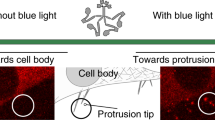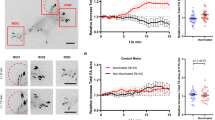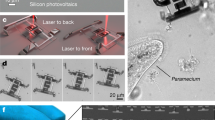A molecular motor in a liquid-crystal film uses light to turn items thousands of times larger than itself.
Abstract
Nanomachines of the future will require molecular-scale motors1,2,3,4,5,6 that can perform work and collectively induce controlled motion of much larger objects. We have designed a synthetic, light-driven molecular motor that is embedded in a liquid-crystal film and can rotate objects placed on the film that exceed the size of the motor molecule by a factor of 10,000. The changes in shape of the motor during the rotary steps cause a remarkable rotational reorganization of the liquid-crystal film and its surface relief, which ultimately causes the rotation of submillimetre-sized particles on the film.
This is a preview of subscription content, access via your institution
Access options
Subscribe to this journal
Receive 51 print issues and online access
$199.00 per year
only $3.90 per issue
Buy this article
- Purchase on SpringerLink
- Instant access to full article PDF
Prices may be subject to local taxes which are calculated during checkout

Similar content being viewed by others
References
Schliwa, M. (ed.) Molecular Motors (Wiley, Weinheim, 2003).
Balzani, V., Venturi, M., Credi, A. Molecular Devices and Machines: A Journey into the Nanoworld (Wiley, Weinheim, 2004).
Kelly, T. R., De Silva, H. & Silva, R. A. Nature 401, 150–152 (1999).
Koumura, N., Zijlstra, R. W. J., van Delden, R. A., Harada, N. & Feringa, B. L. Nature 401, 152–155 (1999).
Leigh, D. A., Wong, J. K. Y., Dehez, F. & Zerbetto, F. Nature 424, 174–179 (2003).
Liu, Y. et al. J. Am. Chem. Soc. 127, 9745–9759 (2005).
Koumura, N., Geertsema, E. M., Meetsma, A. & Feringa, B. L. J. Am. Chem. Soc. 122, 12005–12006 (2000).
Dierking, I. Textures of Liquid Crystals (Wiley, Weinheim, 2003).
Author information
Authors and Affiliations
Corresponding author
Ethics declarations
Competing interests
The authors declare no competing financial interests.
Supplementary information
Supplementary video 1
This video shows the rotational rearrangement of a liquid crystalline film doped with molecular motor 1, during irradiation with 365 nm light. The rotation is shown in real time. (QT 8022 kb)
Supplementary video 2a
This video shows the rotation of a glass rod on a liquid crystalline film doped with molecular motor 1, during irradiation with 365 nm light. This video was sped up eight times, to clarify the rotation movement of the object. (QT 3168 kb)
Supplementary video 2b
This video shows the same process as Supplementary Video 2a, in real time. (QT 8801 kb)
Supplementary information
(DOC 183 kb)
Rights and permissions
About this article
Cite this article
Eelkema, R., Pollard, M., Vicario, J. et al. Nanomotor rotates microscale objects. Nature 440, 163 (2006). https://doi.org/10.1038/440163a
Received:
Accepted:
Published:
Issue Date:
DOI: https://doi.org/10.1038/440163a



